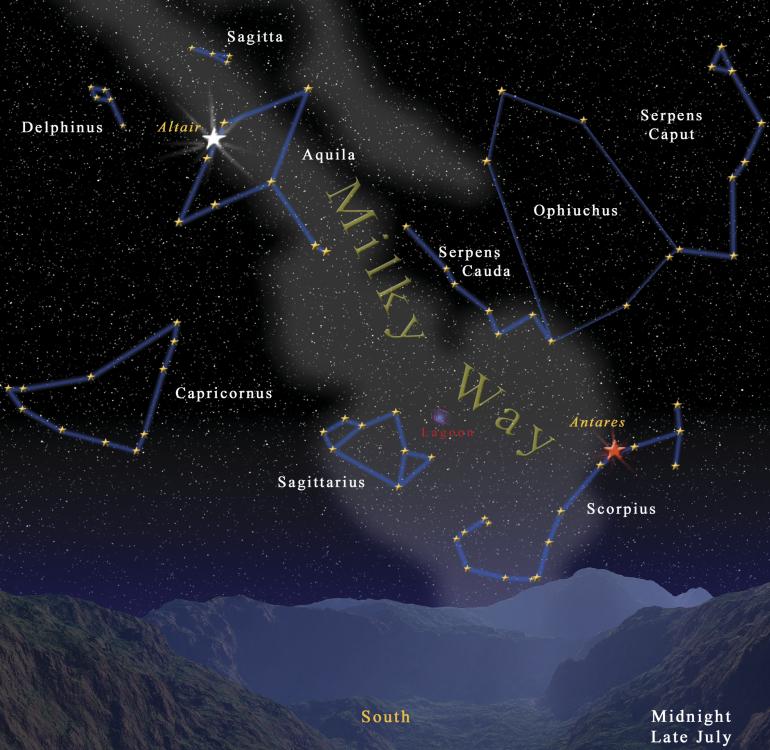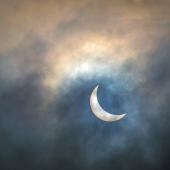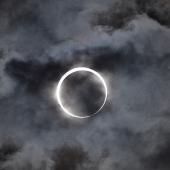The Celestial Coffee Pot
How to find a caffeinated constellation.
Whether you’re a saddle-weary cowpoke or a wilderness adventurer, there seems to be one gastronomical truth about the Western mythos of outdoor living: at the end of a long, hard day on the range, the ridge, or the river, no Western campfire would seem complete without its coffee pot, ready to take the edge off the evening chill. And in the summertime, when outdoor living is at its height, the sky has one, too.Eastern dudes might call it the “teapot,” but when it slides along the southern horizon on starry nights after busy days, “coffee pot” sounds just about right. The shape is unmistakable: three stars in a triangle make the spout, four more to the spout’s left make the handle, and an eighth above marks the pointy top. And the glow of the Milky Way stretching up from the south looks like a cloud of steam rising from the spout, telling you the coffee’s done.The stars of the Coffee Pot make up the brightest parts of what is officially known as Sagittarius the archer—one of the ancient constellations of the zodiac. The Sumerians saw Nergal, their archer god of war, among these stars; the spout stars plus the star in the pointy top make the outline of the bow and arrow. Among Native American cultures, the Navajo used parts of it along with parts of curly Scorpius to its right to make a constellation called First Big One, and the Pawnee are said to have placed a bear here. But the Greeks adopted the Sumerian notion, and Sagittarius (whose name comes from the Romans) has been a bow hunter ever since.But Sagittarius is no conventional archer. He’s pictured as a centaur, sporting the torso of a man on the four-legged body of a horse. The front of the Coffee Pot still makes the bow and arrow (aimed provocatively at Antares, the beating red heart-star of Scorpius), the pot handle marks the human torso, and the sprinkle of fainter stars southeastward of the pot is where we must imagine the horsey section of the archer. Some legends say that Sagittarius was the famous centaur Cheiron, a wise creature who tutored such famous Greek heroes as Achilles and Jason, was accidentally killed by another—Hercules—and was subsequently placed in the sky. But there’s another centaur constellation farther south in the sky—Centaurus—and some say that this is Cheiron. In that case, other authorities say that Sagittarius is actually Crotus, the satyr son of Pan and the nymph Eupheme. Eupheme was the nurse of the Muses, the nine lovely daughters of Zeus who served as the patronesses of the arts and sciences. And so Crotus grew up, in effect, with nine foster sisters. He was said to have invented archery and often hunted on horseback (giving him a somewhat centaur form), and especially, hung around with the Muses on Mount Helicon where he applauded their singing, laughed at their jokes, and they all got along famously. So famously, in fact, that the Muses asked their father to immortalize him in the sky, and so Zeus did—as Sagittarius.Today Sagittarius is famous for pointing us in the direction of the center of our Milky Way Galaxy, which lies about 30,000 light years beyond it. It makes Sagittarius crowded with celestial sights. The Lagoon Nebula, hovering above the coffee pot spout, can be seen as a faint naked-eye glow in a dark sky; binoculars show it as a glowing patch of gas in a great star nursery about 5,000 light years away. Run the binoculars northward of the Lagoon, and you’ll find the Milky here clotted with star clouds, clusters, and other nebulae.Keep going, through the pattern of Aquila, the eagle, and you’ll come to the little constellation of Sagitta, the arrow, said by some to belong to Hercules. But only Sagittarius has a quiver in the sky. It works better as a stray arrow from the archer—for even the most accomplished bow hunters, if they’re honest, will tell you that every once in while, one will get away from you. And so it seems for Sagittarius. But it’s only one, and even in the sky, you’ve got to play the odds. Something to think about, perhaps, as you sip your coffee alongside that comforting campfire under the twinkling campfires of the sky.
The Taylor Planetarium offers guided tours of the universe daily at the Museum of the Rockies.













